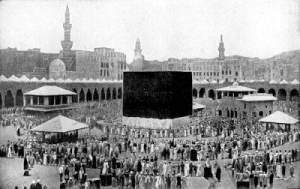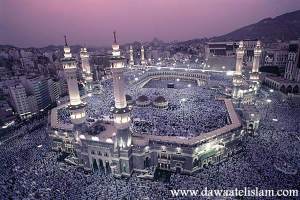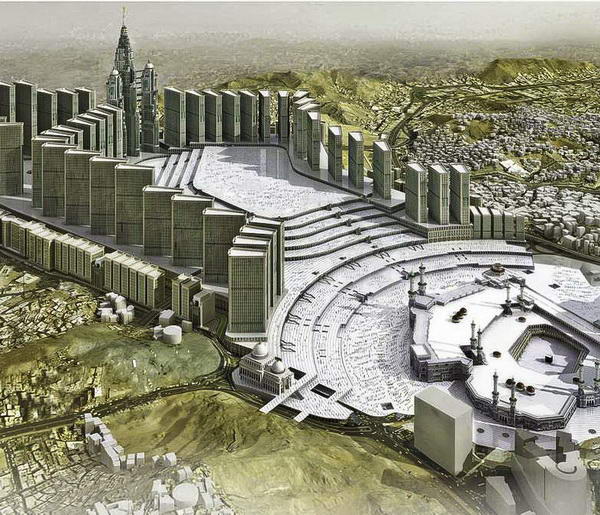Sparkling and flashy. That depiction of the New York Times about the Muslim holy city, Mecca. The paper describes an elegant work of Mecca as a form of modern civilization which is marked with a header from a skyscraper-building and tower at Mecca is very high. That does not include building a luxury shopping mall or a first-class hotel.
According to the NY Times, the destruction of the Ottoman heritage buildings of the 18th century is very comparable to current building demolition although it should not be done. "This is a form of commercialization of the house of God," said Sami Angawi, the Saudi architect who was mengarap research on the issue of pilgrimage.
"Just imagine, a building near the mosque stands a luxury apartment for rent at private parties for 25 years. So, if you want to see the sights of the Grand Mosque then you have to pay three times as much, "he said as quoted by the NY Times last week.
In tulisanya, NY Times also criticized the government of Saudi Arabia which is considered neglect accommodation Mecca population growth by creating buildings that actually make a narrow space for the pilgrims. "From the view of architects, and government officials, the motive of the development of Mecca is money. Fruit desire to profit from the city that is very sacred, "NY Times critic.
The newspaper also added that excessive exploitation of Makkah to threaten the existence of relics of the Prophet Muhammad. The mentality was assessed NY Times dividing the holy city of Mecca. "All the observations can look luxurious and exclusive buildings around the holy mosque and make the poor increasingly marginalized," wrote the NY Times.
NY Times recognizes the development of the city of Mecca is much more than the big city western states like New York. Development projects that have never been made before, an original work of an expert.
Just look at the architectural style of the work of Frei Otto's tent city built in the 1970s. These buildings consist of lightweight structures can be folded. The work of Otto inspired by tradition nomadic Bedouin tribes. The building was built to accommodate pilgrims without damaging the delicate ecology of the hills that surround the old city. The work was not the only one.
Extraordinary work is also reflected in the construction of Haj terminal at Skidmore, Owings & Merrill, King Abdul Aziz International Airport. Terminal building was so touching local traditions and wisdom of the environment without losing side modernitasnya
According to the NY Times, the destruction of the Ottoman heritage buildings of the 18th century is very comparable to current building demolition although it should not be done. "This is a form of commercialization of the house of God," said Sami Angawi, the Saudi architect who was mengarap research on the issue of pilgrimage.
"Just imagine, a building near the mosque stands a luxury apartment for rent at private parties for 25 years. So, if you want to see the sights of the Grand Mosque then you have to pay three times as much, "he said as quoted by the NY Times last week.
In tulisanya, NY Times also criticized the government of Saudi Arabia which is considered neglect accommodation Mecca population growth by creating buildings that actually make a narrow space for the pilgrims. "From the view of architects, and government officials, the motive of the development of Mecca is money. Fruit desire to profit from the city that is very sacred, "NY Times critic.
The newspaper also added that excessive exploitation of Makkah to threaten the existence of relics of the Prophet Muhammad. The mentality was assessed NY Times dividing the holy city of Mecca. "All the observations can look luxurious and exclusive buildings around the holy mosque and make the poor increasingly marginalized," wrote the NY Times.
NY Times recognizes the development of the city of Mecca is much more than the big city western states like New York. Development projects that have never been made before, an original work of an expert.
Just look at the architectural style of the work of Frei Otto's tent city built in the 1970s. These buildings consist of lightweight structures can be folded. The work of Otto inspired by tradition nomadic Bedouin tribes. The building was built to accommodate pilgrims without damaging the delicate ecology of the hills that surround the old city. The work was not the only one.
Extraordinary work is also reflected in the construction of Haj terminal at Skidmore, Owings & Merrill, King Abdul Aziz International Airport. Terminal building was so touching local traditions and wisdom of the environment without losing side modernitasnya

Makkah Grand Mosque Now

The future of Makkah Haram






0 comments
Post a Comment